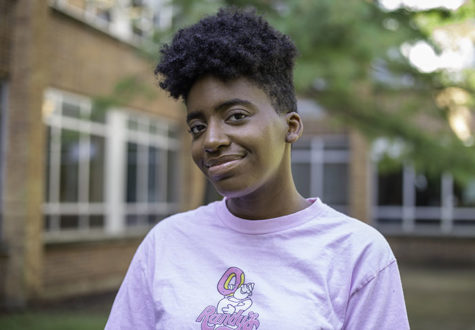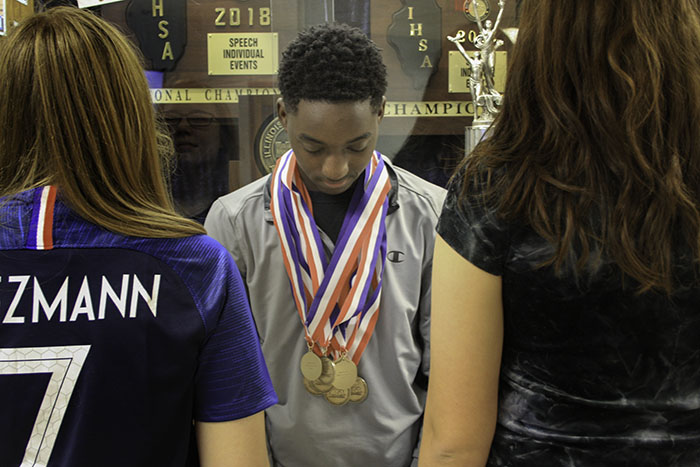Deeper than the roster: the lack of minority representation in activities at DGS
In 2016-2017, the DGS student body population was 60% white, 20% Latino, 11% black , 7% Asian and 2% other.
At DGS, students from different racial and ethnic backgrounds have a multitude of experiences — good and bad — that affect how involved they can be in our clubs and activities.
During the 2016-17 school year, the demographics of the DGS student body were 60% white, 20% Hispanic, 11% black, 7% Asian and 2% other.
The DGS student population consists of a little under 3,000 students, with graduating classes that can be up to 700. Because of the success of DGS sports and activities, the school can be viewed as an innovative institution.
Some of these activities include many speech and conference championships, recognized national merit scholars and DGS band and choir members who are constantly awarded for their artistic excellence. Students of color are disproportionately represented in the clubs and activities at DGS.
Drama club sponsor, English teacher and one of the few minorities within the teaching staff Nathaniel Haywood comments on the lack of diversity within clubs and sports.
“In Drama Club, there isn’t as much diversity as we would like to have considering the population of the school. Part of it is just because some minority students don’t view drama as something for them for whatever reason. I think for students to take that first step to view it as something that is for them and not just the majority can be a hurdle,” Haywood said.
Speech team member and former volleyball player junior Hewane Melkie believes that the lack of representation is deeper than just lack of interest and dives into stereotyping in the school environment.
“I think the lack of representation might be due to the fact that people might be scared of what others may say or simply don’t want to go against any stereotypes or expectations. I also think it might be due to where DGS is on the map. If you live in a town where the majority race is white, then the school is probably going to have that also,” Melkie said.
Motivation to be involved in activities and sports outside of the classroom can be heavily affected by the way students of color are treated inside of the classroom.
Junior and member of the JV cheerleading team Daisja Honorable recognizes that there are some instances in which she is singled out in the classroom.
“I remember last year in my U.S. History class when we were talking about the n-word everyone seemed surprised when I didn’t want anyone to say the word, and that I wasn’t angry about the topic,” Honorable said.
Melkie notes how the color of her skin can affect the way she is approached by teachers, especially being an honors student, who claims she does not fit into the stereotype of a typical black girl.
“I feel like one thing that used to always happen to myself and a friend of mine is teachers would constantly ask why we had such an ‘attitude’ before we would even open our mouths. They would see us and just assume we were going to be problematic, sassy, or troublesome kids based of the fact that were are black girls,” Melkie said.
Senior Snowball leader and former dancer Izabella Vega feels she also had unique experiences in an activity at DGS because of the color of her skin.
“My experience on a not diverse sport like the dance team was peculiar. I felt that because of my Latin culture and salsa style that I was able to add my creativity and style to the team. Although, I often felt like an outsider out of my small groups of friends because they were mostly minorities and I was always around white people,” Vega said.
Junior Caleb Johnson who is a former member of stage crew and a current member of hair and makeup crew has also had experiences in which he felt as if his skin color was a floating question in the air.
“Being the only black person on stage crew during freshman and sophomore year was met with shock as I was the first ever to join stage crew for as long as the current seniors had remembered. Someone said I ‘didn’t even act black’,” Johnson said.
A non-minority, junior Catherine Kammerer notices the biases held toward some students of color in her everyday interactions at DGS.
“People are often singled out by classmates or even faculty at South, and I personally think a lot of it has to do with immaturity. I hear a lot of people making snarky comments that sometimes bring a person’s race into it and I just think to myself at how pointless it is. Not only do people verbally get singled out, but in my classes, in particular, there are barely even four minorities in them. I cannot imagine how hard it would be to be in a class with almost all white people and being the only person of color,” Kammerer said.
Although there are some acts of injustice in certain areas, Johnson says that he personally does not experience stark acts of discrimination, but the experience is different for all. He believes there are still problems within the system.
“Most everyone I’ve met doesn’t care about race so I’m not treated any different or ‘special,’ even when I’m the only black person in one of my classes. This doesn’t signify the end of racism, though, as I’ve heard plenty of racist comments in the halls or have been told racist things outside of school, but usually school isn’t a place where I’m made of my race on a regular basis,” Johnson said.
Being a minority within the DGS teaching staff, Haywood believes that minority students not being reflected within their environment can affect the way they view their own opportunities in the future.
“With anybody, when you see yourself reflected where you work, where you go to school, et cetera, that adds a little comfort and familiarity [that] can impact your experience. But I believe it impacts the students more than it impacts me just because a lot of minority students’ parents will tell me I am the first black teacher the student has had, and things of that nature. So when you never see people like yourself represented in authority, that can definitely affect students,” Haywood said.
Because of the portrayed gap in what a student can do because of their race, some students have to train themselves to not follow the path that has been paved for them by society.
“People expect you to join or do certain things based on your race and we can’t really erase that because it becomes engraved and expected. Of course, everyone has heard and grown around the stereotypes that come along with each race and we can’t undo that and sometimes they make us question ourselves and the way we are perceived but it should never stop anyone from doing what they want,” Melkie said.
DGS attempts to grow away from this diversity gap by implementing clubs that join minorities together so they can have representation that way. Although this is a step in the right direction, non-minority senior Reese Clemens believes it does not solve the problem at hand.
“Even in clubs like Caribbean soul and steppers, it is not different people coming together — it is just many members of the same ethnic group or race. It is usually just white people unless it is a club associated within a certain culture,” Clemens said.
As a teacher of color, Haywood tries his best to influence students of color when they need extra motivation because of their environments in and out of school.
“If there are students of color in the room, I try to make connections with them and let them know they can come to me with issues and when there happens to be a situation where a student is lacking a role model in their home, then I will try to step up and fill that void so I try to do as much as I can,” Haywood said.
Even with these problems, minorities are still constantly proving themselves to be just as capable as anyone else in the school. A lot of minority students are stepping up and not allowing the color of their skin to be a barrier between what they can achieve; however, we still have a long way to go in order to close the diversity gap at DGS and it starts with recognizing the problem that exists.
“I’m a firm believer in you never really know unless you try,” Melkie said. “If you’re interested in something, you shouldn’t let the fear of a stereotype of your race hold you back. I understand that this is easier said than done but if you don’t begin the diversifying of that activity, who will?”




Robert • Oct 26, 2018 at 7:50 pm
A very interesting article from an array of introspective individuals. Great job.